The Great Pyramid at Giza, also called Khufu's Pyramid or the Pyramid of Khufu, and Pyramid of Cheops, is the oldest and largest of the three pyramids in the Giza Necropolis bordering what is now Cairo, Egypt, and is the only remaining member of the Seven Wonders of the Ancient World. It is believed the pyramid was built as a tomb for Fourth dynasty Egyptian King Khufu (Cheops in Greek) and constructed over a 20 year period concluding around 2560 BC.
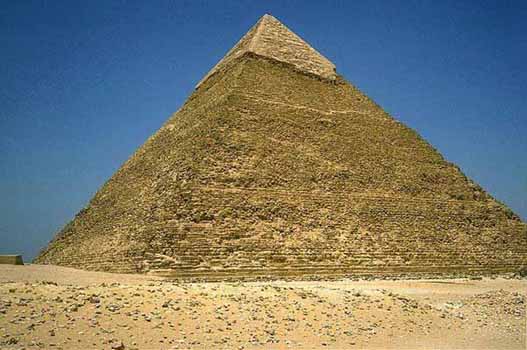
The Great Pyramid was the tallest man-made structure in the world for over 3,800 years. Originally the Great Pyramid was covered by casing stones that formed a smooth outer surface, and what is seen today is the underlying core structure. Some of the casing stones that once covered the structure can still be seen around the base. There have been varying scientific and alternative theories regarding the Great Pyramid's construction techniques. Most accepted construction theories are based on the idea that it was built by moving huge stones from a quarry and dragging and lifting them into place.
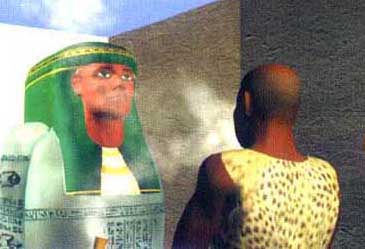
It is believed the pyramid was built as a tomb for Fourth dynasty Egyptian pharaoh Khufu and constructed over a 14 to 20 year period concluding around 2560 BC. Khufu's vizier, Hemon, or Hemiunu, is believed by some to be the architect of the Great Pyramid. At the time of construction, the Great Pyramid was 280 Egyptian royal cubits tall, 146.6 meters, (480.97 feet) but with erosion and the loss of its pyramidion, its current height is 138.8 m (455 feet). Each base side was 440 royal cubits, with each royal cubit measuring 0.524 meters.
The total mass of the pyramid is estimated at 5.9 million tonnes. The volume, including an internal hillock, is believed to be roughly 2,500,000 cubic meters.
Based on these estimates building this in 20 years would involve installing approximately 800 tonnes of stone every day. The first precision measurements of the pyramid were done by Egyptologist Sir Flinders Petrie in 1880-82 and published as The Pyramids and Temples of Gizeh. Almost all reports are based on his measurements. Petrie found the pyramid is oriented 4' west of North and the second pyramid is similarly oriented.
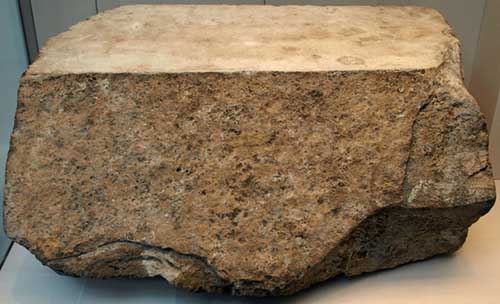
Many of the casing stones and interior chamber blocks of the great pyramid were fit together with extremely high precision. Based on measurements taken on the north eastern casing stones, the mean opening of the joints are only 1/50th of an inch wide.
The pyramid remained the tallest man-made structure in the world for over 3,800 years, unsurpassed until the 160 meter tall spire of Lincoln Cathedral was completed c. 1300.
The accuracy of the pyramid's workmanship is such that the four sides of the base have a mean error of only 58 millimeter in length, and 1 minute in angle from a perfect square.
The base is horizontal and flat to within 15 mm. The sides of the square are closely aligned to the four cardinal compass points (within 3 minutes of arc based on true north not magnetic north).
The completed design dimensions, as suggested by Petrie's survey and later studies, are estimated to have originally been 280 cubits in height by 440 cubits in length at each of the four sides of its base. These proportions equate to an accuracy of better than 0.05% which some Egyptologists consider to have been the result of deliberate design proportion.

The Great Pyramid consists of more than 2.3 million limestone blocks. The Egyptians shipped the limestone blocks from quarries all along the Nile River. The stone was cut by hammering wedges into the stone. Then, the wedges were soaked with water. The wedges expanded, causing the rock to crack. Once they were cut, they were carried by boat either up or down the Nile River to the pyramid.
At completion, the Great Pyramid was surfaced by white 'casing stones' slant-faced, but flat-topped, blocks of highly polished white limestone. Visibly all that remains is the underlying step-pyramid core structure seen today. In AD 1301, a massive earthquake loosened many of the outer casing stones, which were then carted away by Bahri Sultan An-Nasir Nasir-ad-Din al-Hasan in 1356 in order to build mosques and fortresses in nearby Cairo.
The stones can still be seen as parts of these structures to this day. Later explorers reported massive piles of rubble at the base of the pyramids left over from the continuing collapse of the casing stones, which were subsequently cleared away during continuing excavations of the site. Nevertheless, many of the casing stones can be seen to this day in situ around the base of the Great Pyramid, and display the same workmanship and precision as has been reported for centuries. Petrie also found a different orientation in the core and in the casing measuring 193 centimeters ± 25 centimeters. He suggested a redetermination of north was made after the construction of the core, but a mistake was made, and the casing was built with a different orientation.
There have been varying alternative theories proposed regarding the Pyramid's construction techniques. Most accepted construction theories are based on the idea that it was built by moving huge stones from a quarry and dragging and lifting them into place. The disagreements center on the method by which the stones were conveyed and placed. In addition to the many theories as to the techniques involved, there are also disagreements as to the kind of workforce that was used.
One theory, suggested by the Greeks, posits that slaves were forced to work until the pyramid was done. This theory is no longer accepted in the modern era, however. Egyptologists believe that the Great Pyramid was built by tens of thousands of skilled workers who camped near the pyramids and worked for a salary or as a form of paying taxes until the construction was completed (citation needed).
The worker's cemeteries were discovered in 1990 by archaeologists Zahi Hawass and Mark Lehner. Verner posited that the labor was organized into a hierarchy, consisting of two gangs of 100,000 men, divided into five zaa or phyle of 20,000 men each, which may have been further divided according to the skills of the workers.
One of the mysteries of the pyramid's construction is how they planned its construction. John Romer suggests that they used the same method that had been used for earlier and later constructions, laying out parts of the plan on the ground at a 1 to 1 scale. He writes that "such a working diagram would also serve to generate the architecture of the pyramid with a precision unmatched by any other means." He devotes a chapter of his book to the physical evidence that there was such a plan.
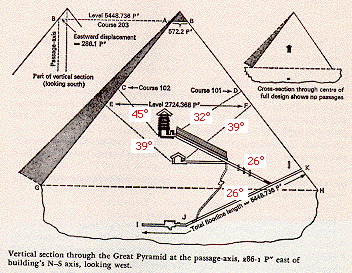
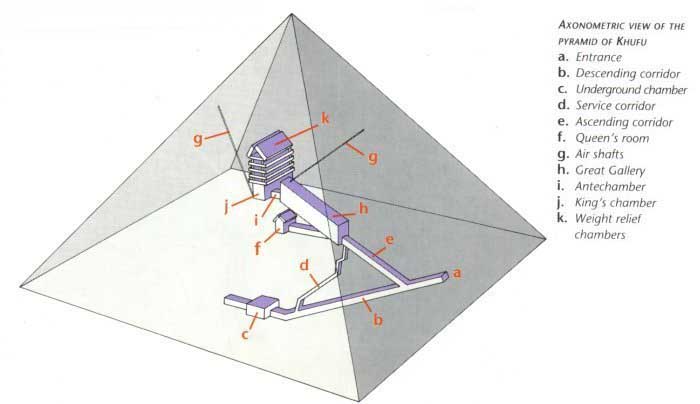
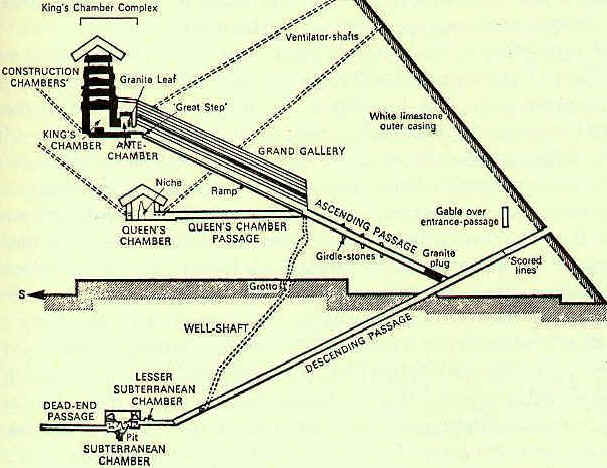
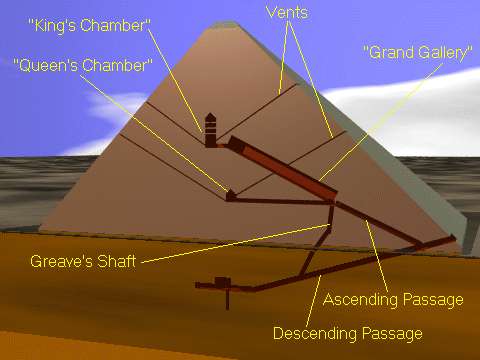

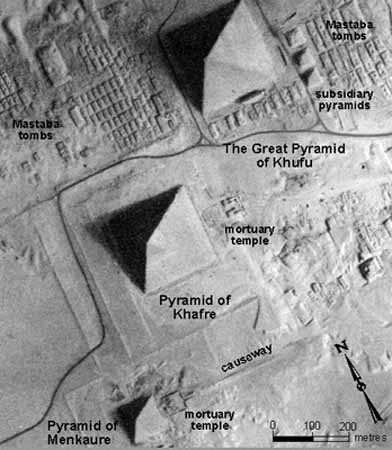
Aerial View, Giza Plateau
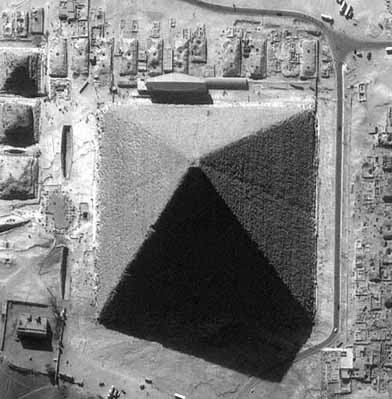
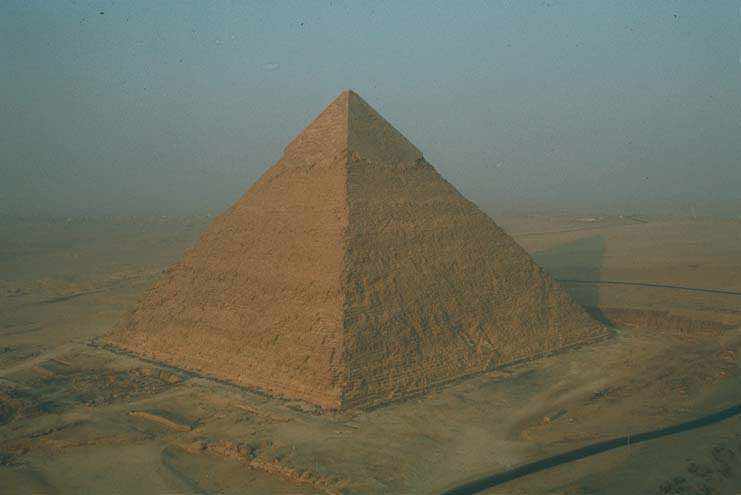
Eye of Horus (Ra, God) Sacred Geometry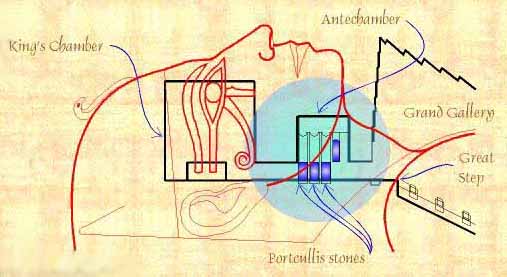
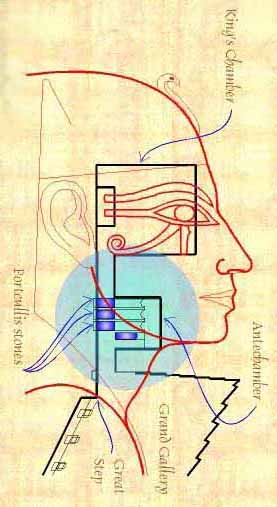
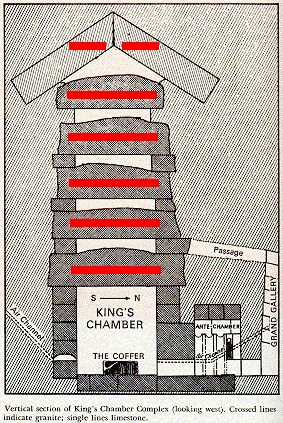
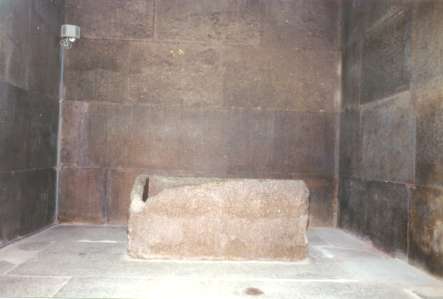
At the end of the lengthy series of entrance ways leading into the interior is the structure's main chamber, the King's Chamber. Some believe that this is consistent with the geometric methods for determining the Golden Ratio (phi), which can be derived from other dimensions of the pyramid, such that if had been the design objective, then automatically follows to 'square the circle'.
The sarcophagus of the King's Chamber was hollowed out of a single piece of Red Aswan granite and has been found to be too large to fit through the passageway leading to the chamber. Whether the sarcophagus was ever intended to house a body is unknown. It is too short to accommodate a medium height individual without the bending of the knees, a technique not practiced in Egyptian burial, and no lid was ever found. The King's Chamber contains two small shafts that ascend out of the pyramid. These shafts were once thought to have been used for ventilation, but this idea was eventually abandoned, which left Egyptologists to conclude they were instead used for ceremonial purposes. It is now thought that they were to allow the Pharaoh's spirit to rise up and out to heaven.
The King's Chamber is lined with red granite brought from Aswan 935 km (580 miles) to the south. There are 5 relieving chambers above the kings chamber. The first one is reached through a breach in the wall at the upper end of the Grand Gallery, this was named the Davidson chamber. Howard Vyse suspected there was another chamber above this when he found that he was able to thrust a long reed through a crack in the ceiling. He blasted through to find 4 more relieving chambers. These chambers were named the Wellington, Nelson, Lady Arbuthnot and Cambell's chambers. The kings chamber and the first 4 relieving chambers have roofs made out granite. Each roof includes 8 or 9 granite slabs weighing 25 to 80 tonnes each. Cambell's chamber has a pented roof made of large limestone slabs. Egyptologists believe they were transported on barges down the Nile river.

The Queen's Chamber is the middle and the smallest, measuring approximately 5.74 by 5.23 meters, and 4.57 meters in height. The chamber is lined with fine limestone blocks and the pented roof is made of large limestone slabs. Its eastern wall has a large angular doorway or niche. Egyptologist Mark Lehner believes that the Queen's chamber was intended as a serdab, a structure found in several other Egyptian pyramids, and that the niche would have contained a statue of the interred. The Ancient Egyptians believed that the statue would serve as a "back up" vessel for the Ka of the Pharaoh, should the original mummified body be destroyed. The true purpose of the chamber, however, remains uncertain.
The Queens Chamber has a pair of shafts similar to those in the King's Chamber, which were explored using a robot, Upuaut 2, created by the German engineer Rudolf Gantenbrink. In 1992, Upuaut 2 discovered that these shafts were blocked by limestone "doors" with two eroded copper handles. The National Geographic Society filmed the drilling of a small hole in the southern door, only to find another larger door behind it. The northern passage, which was harder to navigate due to twists and turns, was also found to be blocked by a door.
The "unfinished chamber" lies 27.5 meters below ground level and is rough-hewn, lacking the precision of the other chambers. Egyptologists suggest the chamber was intended to be the original burial chamber, but that King Khufu later changed his mind and wanted it to be higher up in the pyramid.
The Great Pyramid of Giza is the main part of a complex setting of buildings that included two mortuary temples in honor of Khufu (one close to the pyramid and one near the Nile), three smaller pyramids for Khufu's wives, an even smaller "satellite" pyramid, a raised causeway connecting the two temples, and small mastaba tombs surrounding the pyramid for nobles. One of the small pyramids contains the tomb of queen Hetepheres (discovered in 1925), sister and wife of Sneferu and the mother of Khufu. There was a town for the workers of Giza, which included a cemetery, bakeries, a beer factory and a copper smelting complex.
A few hundred meters south-west of the Great Pyramid lies the slightly smaller Pyramid of Khafre, one of Khufu's successors who is also commonly considered the builder of the Great Sphinx, and a few hundred meters further south-west is the Pyramid of Menkaure, Khafre's successor, which is about half as tall. In May 1954, 41 blocking stones were uncovered close to the south side of the Great Pyramid. They covered a 30.8 meter long rock-cut pit that contained the remains of a 43 meter long ship of cedar wood. In antiquity, it had been dismantled into 650 parts comprising 1224 pieces. This funeral boat of Khufu has been reconstructed and is now housed in a museum on the site of its discovery. A second boat pit was later discovered nearby.
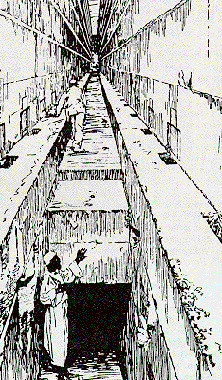
The Grand Gallery has 7-step corbeled side walls. Some parts of the Grand Gallery walls contain salt deposits, but not as much as in the Mid Chamber. The length of the Grand Gallery is 1881.5985600+ PI, and its width just above the ramp stones is 82.41 PI. The Grand Gallery is 28 feet high by 1881-1/3 PI long.
The length of the horizontal passage to the Queen's Chamber is 1521.31136 PI. The name "Queen's Chamber" is considered a misnomer by Egyptologists since no queens have ever been found in pharaoh's pyramids. The volume of the Queen's Chamber is 9,963,200 cubic PI. The Grand Gallery contains two grooves, one in the east wall and one in the west wall. They are 7 inches high, 1 inch deep, and 5 inches up from the 3rd overlapping corbel. They run the entire length of the gallery. The Queen's Chamber has a gabled roof.
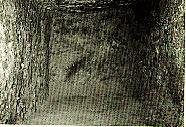
Dead End of Passageway
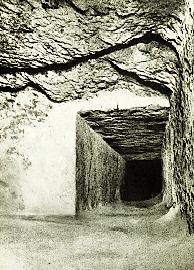
Lesser Subterranean Chamber and Passage
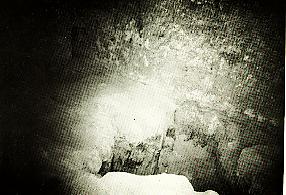
Subterranean Chamber showing contour
round the Pit and entrance doorway
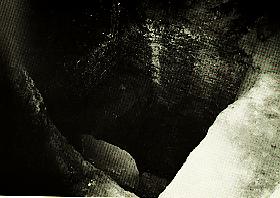
The Pit in the Subterranean Chamber
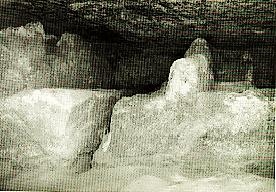
The western half of the Subterranean Chamber
The Pyramid contains two interior chambers and a number of interior shafts. The interior shafts all generally lie in a north-south vertical plane section of the pyramid, displaced a little east of the center of the pyramid:
The Entrance shaft starts at an entrance on the north face, a little above ground level, and descends at an angle of about 26 degrees. Since the latitude of Giza is about 30 degrees North, if you go into the entrance shaft and look back, you will see a part of the sky centered about 4 degrees from the North Pole in the sky. If you could see through the ground and the Earth as you looked forward going down the Entrance shaft, you would see an area near the South Pole in the sky.




0 comments:
Post a Comment